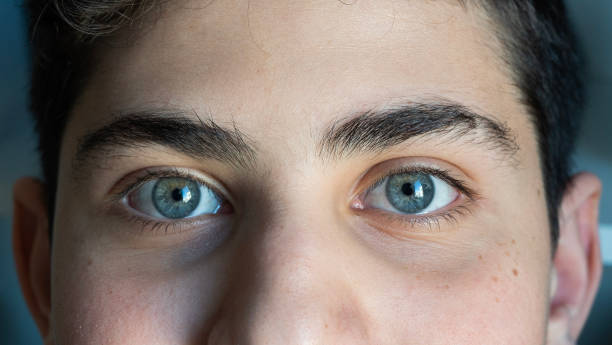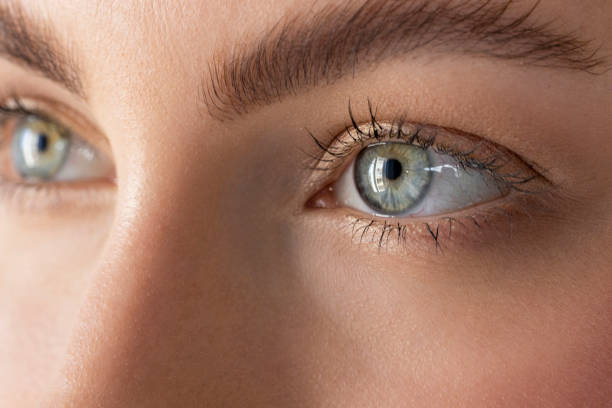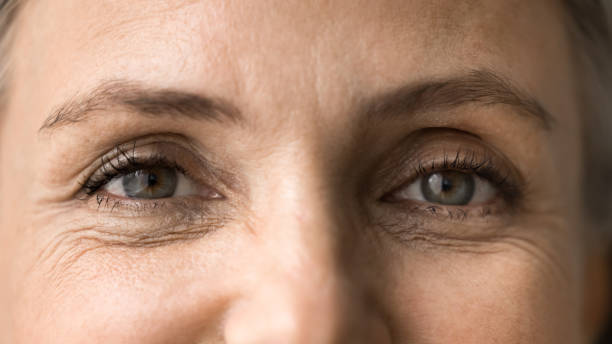Our eyes are amazing machines that work hard every second we’re awake. They capture light from the world around us and turn it into pictures your brain can understand. This process happens in less than a blink, yet it involves many complex parts working together. Knowing how your eyes work helps you spot problems early and take steps to protect them.
In this post, we’ll break the science of sight into plain language you can follow. You’ll learn about eye anatomy, how focus and color vision happen, what causes common vision problems, and simple daily tips to keep your eyesight sharp for years to come.
What is vision? — The big picture
Vision is more than just seeing shapes or colors. It’s a complex process that happens in several steps. First, your eyes collect light through the cornea and lens, focusing it on the retina at the back of your eye. The retina is lined with special cells that change light into electrical signals. These signals travel through the optic nerve like messages on a high-speed cable.
Finally, your brain reads those messages and creates the image you see. This means vision is a true team effort: your eyes gather the light, your nerves carry the data, and your brain puts it all together into a clear picture of the world. (Cleveland Clinic, National Eye Institute)

Eye anatomy — Main parts and what they do
Here’s a simple tour of the parts you’ll hear about the most.
Cornea and lens — the eye’s camera lens
- Cornea: The cornea is the clear front window of the eye. It’s the first part that light hits, and it bends, or refracts, the light so it starts focusing in the right direction. A healthy cornea is smooth and curved, which helps make vision sharp and clear. (National Eye Institute)
- Pupil & iris: The pupil is the dark, round opening in the center of your eye. The iris is the colored ring around it. Together, they control how much light enters your eye. In bright light, the iris makes the pupil smaller. In dim light, it opens wider so you can see better.
- Lens: The lens sits right behind the pupil. It works like a fine-tuning tool for focus. By changing its shape, the lens can make objects look clear whether they are close or far away. This process is called accommodation, and it happens in a fraction of a second.
Retina — where light becomes signals
- Retina: The retina lines the entire back wall of the eye. It’s a thin, delicate layer that acts like film in a camera, capturing the image you see. It holds millions of light-sensitive cells called rods and cones. Rods help you see in dim or low light and detect shapes. Cones help you see color and fine details, especially in bright light. When light hits these cells, they change it into tiny electrical signals. These signals travel through the optic nerve to the brain, where they are turned into the images you recognize. (American Academy of Ophthalmology, Mayo Clinic)
Optic nerve and brain — the final step
- Optic nerve and brain: After the retina changes light into electrical signals, these signals travel through the optic nerve like messages on a data cable. The optic nerve carries this information from each eye to the brain’s visual center. There, the brain combines the input from both eyes into a single, clear picture. This process gives you depth, color, motion, and detail. Without the brain’s work, the signals would remain just raw data — not sight. Vision is complete only when the eyes, optic nerves, and brain work together. (American Academy of Ophthalmology, Cleveland Clinic)
How the eye focuses — A quick optics lesson
Focus happens in two steps:
- Cornea: The cornea gives most of the eye’s focusing power by bending, or refracting, incoming light. Because it has a fixed shape, it provides a constant level of focus for all the light that enters the eye. A smooth and healthy cornea is important for keeping vision sharp. (National Eye Institute)
- Lens: The lens works with the cornea to make the image even clearer. It fine-tunes focus by changing shape, a process called accommodation. Tiny muscles around the lens pull or relax to change its curve. The lens becomes thicker to focus on near objects, like a page in a book, and flatter to focus on far objects, like mountains in the distance. This change happens in an instant, letting you shift focus smoothly from close-up to far away without even thinking about it.
If the cornea or lens are shaped oddly, light doesn’t land correctly on the retina. That causes common vision problems like nearsightedness, farsightedness, and astigmatism.
Color and detail — How we see hue and sharpness
- Cones: Cones are special cells in the retina that detect color. They are tuned to different wavelengths of light — roughly red, green, and blue. When light hits them, each type of cone sends its own signal to the brain. Your brain then blends these signals to create millions of colors, from soft pastels to vivid brights. Cones work best in daylight and are key for seeing fine details and rich color. (American Academy of Ophthalmology)
- Fovea: The fovea is a tiny, central spot on the retina packed with cones. This small area is responsible for your sharpest, most detailed vision. It’s the part you use when you read, recognize faces, or notice small details in an image. Because the fovea has so many cones and no rods, it provides clear, color-rich sight when you look directly at something. (National Eye Institute)

Common eye problems explained
Here are problems people see most often, in plain language.
- Myopia (nearsightedness): Distant objects look blurry. Often starts in childhood.
- Hyperopia (farsightedness): Near objects are hard to see.
- Astigmatism: Blurred or stretched vision from an oval-shaped cornea.
- Presbyopia: With age, the lens stiffens and you need reading glasses (usually starts in the 40s).
- Cataract: Clouding of the lens that blurs vision; common with aging. (American Academy of Ophthalmology, Mayo Clinic)
- Glaucoma: Increased pressure can damage the optic nerve and cause vision loss if untreated. Early stages often have no symptoms. (MSD Manuals)
- Macular degeneration: Damage to the macula (center of the retina) that impairs central vision. Common in older adults. (Mayo Clinic)
- Dry eye: Eyes don’t make enough tears or the tears evaporate too fast; causes discomfort and blurry vision. (Cleveland Clinic)
If you notice sudden vision loss, flashes, or a curtain-like shadow, seek urgent care. These can be signs of retinal detachment or other emergencies.
How to keep your eyes healthy
Good habits matter. They cut risk and help you see better longer.
Daily habits that help
- Get regular eye exams. Many eye diseases have no early symptoms. Exams catch problems early. (National Eye Institute)
- Wear UV-blocking sunglasses. UV exposure adds risk for cataract and other eye damage. (National Eye Institute)
- Practice the 20-20-20 rule for screen time: every 20 minutes, look at something 20 feet away for 20 seconds to reduce strain. (Cleveland Clinic)
- Blink and hydrate. Blinking spreads tears. Drink water and use lubricating drops if you have dry eye. (Cleveland Clinic)
- Healthy food for eyes: Leafy greens, fish with omega-3s, and colorful fruits help eye health. A balanced diet supports retinal cells. (Mayo Clinic)
Medical steps that help
- Control diabetes and blood pressure. High blood sugar and pressure damage small blood vessels in the eye. (MSD Manuals)
- Follow treatment plans. If you have glaucoma, AMD, or a chronic condition, stick with medications and check-ups. Early treatment often preserves vision. (MSD Manuals)
Tests your eye doctor may use
During an exam, you might see or experience:
- Visual acuity test (reading a chart).
- Refraction test (to fine-tune glasses).
- Slit-lamp exam (bright microscope view of the eye).
- Tonometry (measures eye pressure for glaucoma).
- Retinal exam (dilated pupils let the doctor view the retina). (American Academy of Ophthalmology, National Eye Institute)
These tests are quick and painless. They give a clear picture of eye health.
Myths and facts about eyesight
- Myth: Reading in dim light ruins your sight.
Fact: It causes eye strain but not permanent damage. Take breaks and use good light. (Cleveland Clinic) - Myth: Carrots give you super-vision.
Fact: Carrots have vitamin A and help eye health, but they won’t fix poor optics or genetic conditions. (Mayo Clinic) - Myth: Glasses make your eyes lazy.
Fact: Corrective lenses simply let you see clearly; they don’t make vision worse. (American Academy of Ophthalmology)
When to see an eye doctor
Get checked if you notice:
- Sudden blurred vision or loss of vision.
- Double vision that doesn’t go away.
- Flashes, floaters, or a curtain over your sight.
- Severe eye pain or redness.
- New halos around lights, or rapid worsening of vision. (MSD Manuals)
Routine exams are also important even if you feel fine. Many eye issues start quietly.
Quick FAQ — Fast answers
Q: How often should I have an eye exam?
A: Adults should generally have a full exam every 1–2 years. People with risk factors may need more frequent checks. (National Eye Institute)
Q: Can I prevent age-related vision loss?
A: You can reduce risk by managing health, eating well, avoiding smoking, and getting regular screenings. Some conditions are genetic, but early care helps. (Mayo Clinic, MSD Manuals)
Q: Are sunglasses really necessary?
A: Yes — UV protection reduces some long-term eye damage. Choose sunglasses that block 100% of UV rays. (National Eye Institute)

Simple daily checklist to protect your sight
- Schedule an eye exam if it’s been over a year.
- Wear UV-blocking sunglasses outdoors.
- Use the 20-20-20 rule during screen work.
- Eat leafy greens, fish, and colorful fruits.
- Manage chronic health conditions (diabetes, blood pressure).
- Don’t ignore sudden changes in vision. (National Eye Institute, Cleveland Clinic)
Conclusion — See the difference
Your eyes are complex and precious. A little everyday care goes a long way. Start with one small step today: book an eye exam, update your sunglasses, or try the 20-20-20 rule during your next screen session. Want help writing questions to ask your eye doctor? Or want a short checklist you can save or print? Drop a comment below — tell me what you want and I’ll help make it easy.
Take action now: schedule an eye exam and share this post with someone who needs it. Your sight is worth the small effort.

